Green beans remain one of the most popular of garden vegetables in Australia. They are certainly easy to start from seed, grow readily into large and vigorous plants and are very productive – particularly the climbing cultivars. But do you know which ones to grow in subtropical climates?
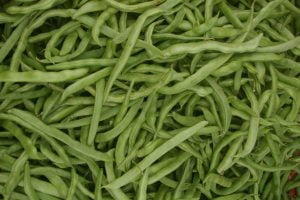
Every spring, as soon as the weather had started to warm, I remember my father building new frames at the very bottom of our garden in preparation for the season’s bean crop, after he had consulted with our neighbor, Mr Doyle, regarding the ideal date for sowing. We grew climbing beans and my favorites were the yellow podded butter beans (known as wax beans in the USA). I recall we also grew purple beans – probably ‘Purple King’. The bean seeds were covered in pink dust. Now I realize that this was a fungicide and pesticide treatment, identified by a red lead coating. I hope we washed our hands when, as children, we helped with the sowing!
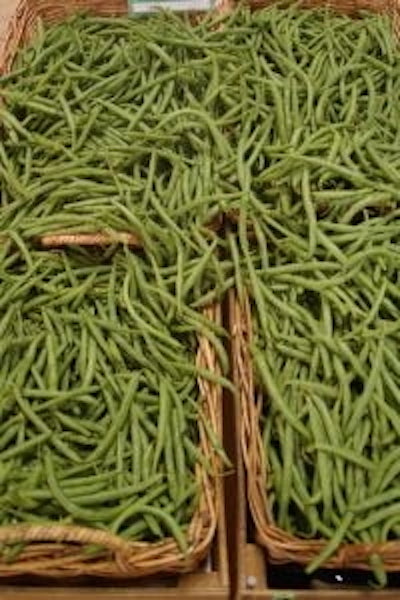
Alongside the bean frames was an old, white, enamel washing tub, sunk to its rim in the ground and filled with water. We would collect seaweed from the beach, and various manures purchased from rural roadside stalls. These went into a hessian sack, which was sunk into the depths of the water and stirred every now and then. Dad would submerge his watering can into the tub and water the beans with this brew.
I remember Dad dug over the sticky clay soil each year prior to planting. We had a large compost bin nearby, so I’m sure compost was added at the same time. But most of all I remember that there were lots and lots of beans, and most evenings we used to pick large handfuls to take inside for dinner.
Beans have remained one of my favorite vegetables. However, living in rental accommodation, and for many more years in my own house that had a heavily shaded garden, I have only started to grow these plants in recent years, now that I have a larger sunny garden. I’m making up for lost time.
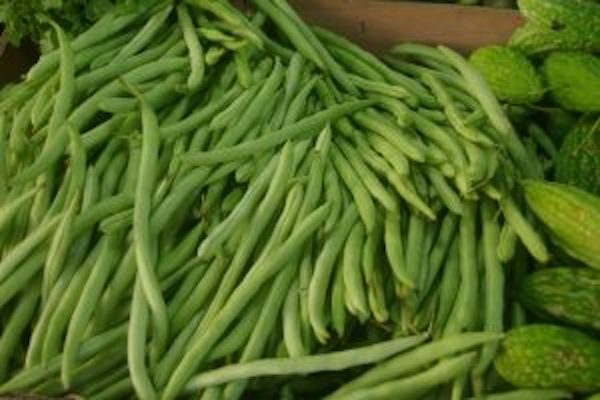
Most beans we grow, whether for their young juicy pods, podded beans or dry beans are cultivars of Phaseolus vulgaris, known variously as green bean, French bean, snap bean or common bean. When dried, the seeds are known as kidney beans or soup beans. The seeds of many beans are specifically eaten when fully formed but still young and tender, and they are known as shelling, flageolet or podded beans. The plants can be climbing (pole) or bush (dwarf) – and of course there are some bean plants that are bushy climbers or climbing bushes and fall somewhere between these two categories.
Like many of our favourite vegetables, beans originate in the Andean regions of the South American continent and were being grown through Central America and up into Mexico and the southern USA before Europeans discovered the ‘New World’. These beans are thought to have originated in Andean Peru and have been cultivated since at least 6000 BC.
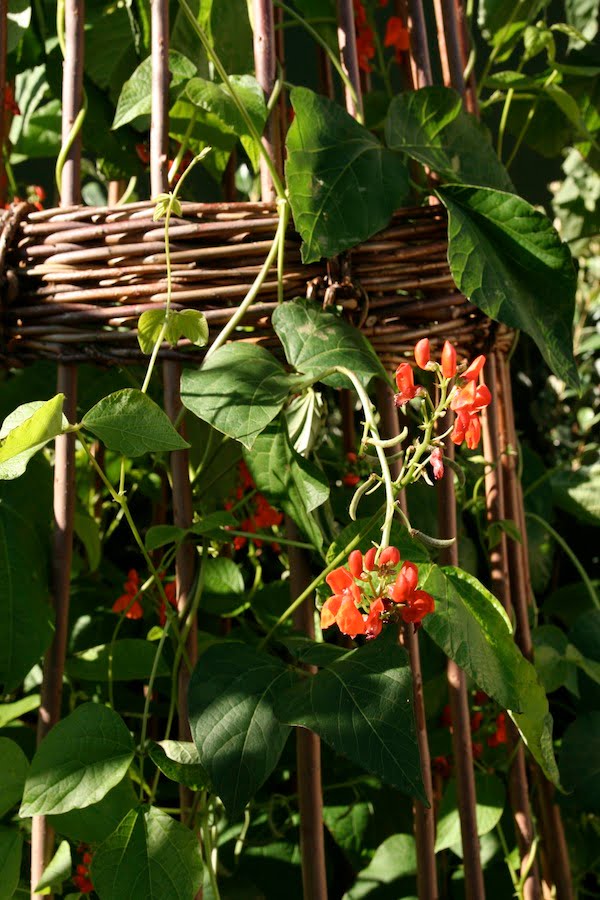
Phaseolus coccineus – scarlet runner bean
If you live in cooler parts of Australia, you might also have come across the scarlet runner bean (Phaseolus coccineus) with its stunning scarlet red flowers (and occasionally pink, or white and scarlet) or the broad or fava Bean (Vicia fava). In the subtropics and tropics, snake beans (Vigna unguiculata var. sesquipedalis) are widely grown during the warmest, wettest months, along with lablab or poor man’s bean (Lablab purpureus) and Madagascar Bean, a type of lima bean (Phaseolus lunatus – named for Lima, the capital of Peru) grown for its large, white seeds covered in red specks.
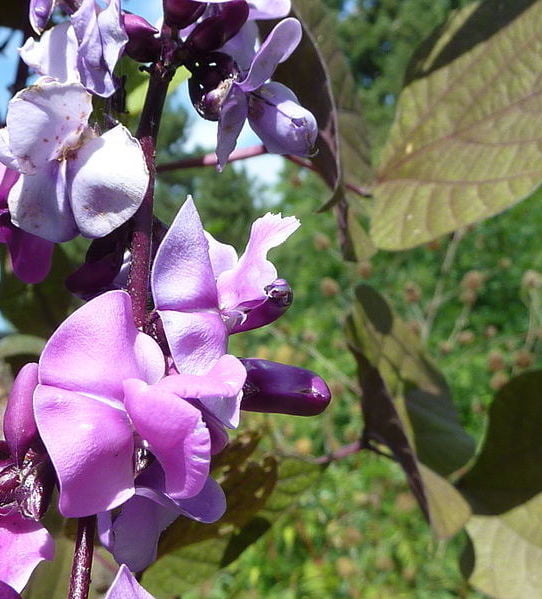
Flowers of Lablab purpureus – lablab or poor man’s bean. Photo Magnus Manske
All of these plants produce beans, however they vary in taste and texture from the green bean and therefore are generally used for specific dishes. I consider that the green bean is the sweetest, juiciest of these beans and the only one I would eat with a big lump of melting butter. However when it comes to curries, stir fries and stews, many of the other beans shine, for they retain their crisp texture and ‘beany’ flavor. It’s ‘horses for courses’.
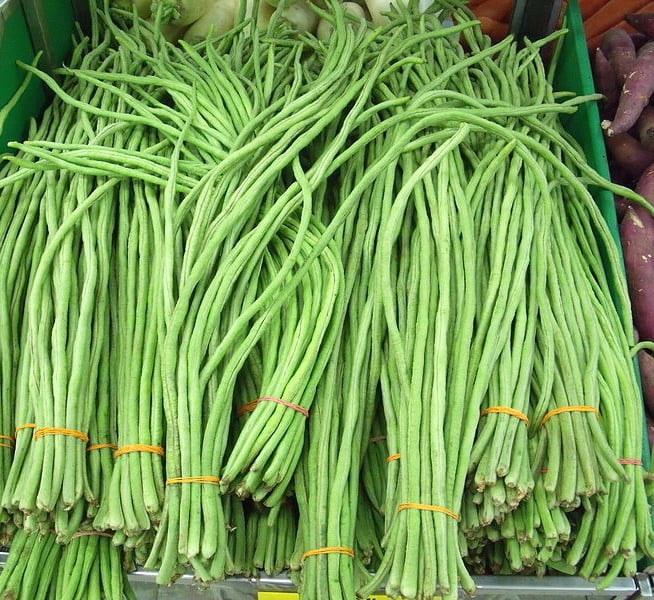
Snake beans in a Singapore market
When to sow beans in the tropics and subtropics
If you live down in the southern parts of Australia, you probably would have sown your beans in spring and would still be picking beans from these productive plants right now. However if you live in the tropics or subtropics, it is countdown time. In the tropics green beans often perish during the warm, wet summer months and snake beans and lablab beans are the staples. In the subtropics we get two shots at sowing – in both spring and autumn. In each case, now that the weather is cooling and the soil is still moist, now is the time for warm climate gardeners to think about which of the many cultivars of Phaseolus vulgaris you wish to grow – and if you don’t have them handy, to locate seed.

Newly planted bean seeds
My suggestion is that you should focus on the climbing beans. These plants produce the heaviest crops, and over a long period. They have a large root system and are more tolerant of temperature and moisture variations. It is certainly easier to pick beans while standing up rather than constantly bending double. If you have a small garden or have back problems, grow climbing beans.
Pairing your climbing beans up with some bush beans is a good idea if you have the space for them. The bush beans will quickly produce beans but they will generally crop for a short time. By the time the bushes are exhausted, the climbing beans will come into production and will provide a more continuous supply of beans over the remaining season.

Butter or wax beans. Photo by Silar
Of course there are always some exceptions, and flavor has to be one. If like me, you are a fan of butter (wax) beans you will want to grow the bush bean ‘Beurre de Rocquencourt’ which has been the gourmet’s choice for over 150 years. Also, if you like to have plenty of dried red or black beans at hand, the bush beans will have to be grown.
Selection
So which beans will you grow?
Do you like green beans or do you prefer butter (wax) beans – or perhaps even purple or fleck podded beans (which unfortunately turn green upon cooking)? Do you prefer round pencil shaped beans or the broad, flat, Roman type pods?
Perhaps you want to grow dry beans for soups, stews, dahls or stir fries? Choose from black, red, yellow, white or multi-colour seeded cultivars depending on the dishes you wish to prepare.
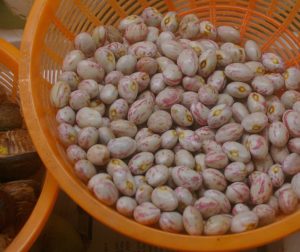
I always try to grow some borlotti beans each year. These delicious, succulent freshly podded beans left a lasting impression on me while spending some autumn months in Florence one year. There are many other beans specifically grown for their succulent freshly podded beans.
If you live in the tropics you will need to select beans that will grow well during the tropical dry season. Conversely if you live in a cool temperate climate you will need to select bean plants that will not produce too late in the season.
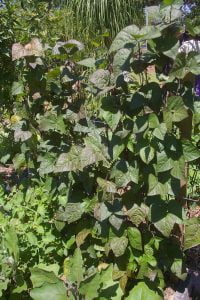
‘Purple King’ has purplish leaves and stems
In the subtropics, with two shots at sowing each year, there is a choice to make as to which climbing cultivars will grow better into the wetter warmer summer period, or conversely into the cooler dryer winter months. There are some ‘stand outs’ such as ‘Purple King’ that seem to tolerate anything we throw at them. However with limited data, it is often a case of trial and error over many seasons, and of course sharing your gleanings with other growers.
Despite their popularity, and compared to many other vegetables, there is still a limited diversity of beans available commercially in Australia. In part this is due to the strict import regulations for bean and pea seed. Seed merchants have been slow to offer a larger selection, particularly of climbing types, and many of the favorites of yesteryear, such as Yates ‘Climbing Butter Bean’, are still hard if not impossible to find. Luckily the range is increasing, and we can now do our searching on line and order directly from the suppliers. There are also seed savers networks and a range of clubs across the country which provide saved seeds for their members and interested growers. Finally there are the growers in your suburb or street who have been growing a favorite bean over many decades and who are happy to share this valuable resource.
Growing beans
Beans are easy to grow, and a great vegetable with which to start your vegetable growing adventure. They are also a great crop for children to sow, nurture and from which to pick the produce.
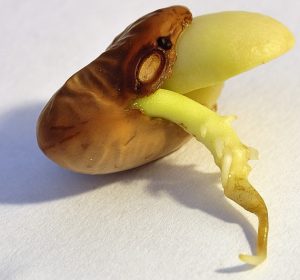
Bean germination Photo Doronenko
Bean seeds respond to soil disturbance and moisture. I had several plants appear miraculously when I had my drive relevelled. The seeds must have been lying there for some time before the disturbance occurred. Bean plants certainly grow much faster and more robustly in soils that have been dug and had compost incorporated. Being hardy plants, they will however tolerate ‘no dig’ practices.
A soil with a neutral pH (7) gives best results. It pays to do a pH test yourself or take a soil sample to your local nursery for analysis. Often soils are slightly too acid for peak growth and a dusting of garden lime can be beneficial. If previous bean crops have shown a tendency to yellowish leaves and green veins, you may also have a magnesium deficiency in which case adding dolomite lime at equal rates to garden lime may assist in better growth. However many soils are naturally high in magnesium so discuss this with your local growers or a horticulturist prior to application.
As you will know, I prefer to use a balanced biological fertiliser in my garden. It generally contains nutrients prepared to an appropriate ratio, often in the form of ground rock minerals which means they are retained in the soil and don’t readily leach during heavy rain. This is especially important in tropical and subtropical areas, as you don’t want to waste your money on unnecessary fertilizer and pollute groundwater. Many biological fertilisers also contain humic acid (humates) and biological inoculants. Remember, for long-term vegetable production, we want to enhance the soil and encourage healthy biological activity.
Having said this, beans don’t need too much fertilizer and it is best applied well before sowing. For this reason beans are often grown in rotation, following salad greens or other greedy crops.
Beans are best grown from seed. Plants are often sold as seedlings, however they resent disturbance and never perform well after transplanting. Save your money and enjoy growing your beans from scratch – it’s a lot more fun.

Young and younger beans. Photo Nick Saltmarsh
As is generally recommended, I soak the seed for a few hours prior to sowing, which seems to ensure almost instant germination. Seeds are sown approximately 5cm (2inches) deep and 200 to 300mm (8 to 12 inches) apart for bush and 300 to 600 mm (1 to 2 feet) apart for climbing beans, depending on the cultivars grown and available space. Sowing two seeds per hole and removing the least vigorous plant is often recommended. However I find I get almost 100% germination and tend to sow a second seed in empty spaces, if this is warranted.
Once plants are growing vigorously, mulch the area, keeping the mulch away from the base of each plant.
Ongoing maintenance involves occasional applications of organic liquid fertilisers during the growing season, regular watering during dry periods and directing climbing shoots where necessary. I have had little problem with pests and diseases and believe in growing healthy vigorous plants and producing a healthy soil. I take care to avoid using chemicals which may harm beneficial insects and drip down into the soil harming essential soil organisms. To control pests I undertake a daily morning inspections while the air is cool and harmful insects are torpid and readily caught.
At the end of the season, as plants decline and the last pods are picked, cut plants at their base and remove them to the compost bin. Retain the nodulated root system in the soil, to allow it to break down and release nitrogen into the soil.
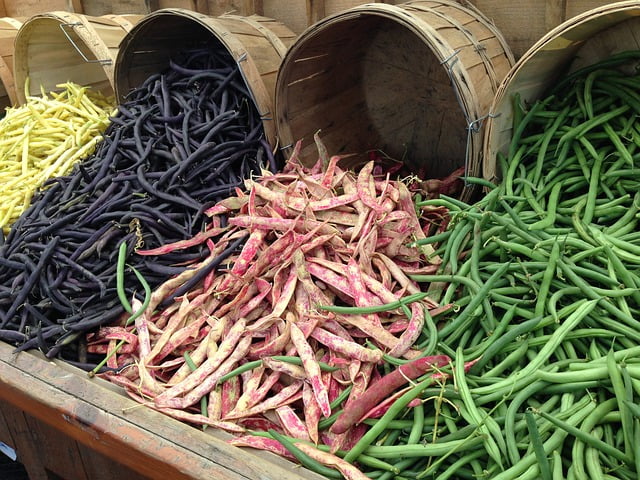
Photo annquasara
Saving seed
Bean seeds are some of the easiest to save. Often it happens by accident – you always miss a few pods. The great thing about beans is that they are self-pollinating and this occurs before the flowers open. Hence you can grow several varieties of beans together in a small space and still retain the original strains. Due to this, we can often track beans grown today back to those cultivars being grown in Europe, the USA or Central and South America a century or more ago.
The other great thing about seed saving is that you can select seeds each season from your most vigorous climbers or bushes and develop a strain that is best suited to your climate, resistant to local pests or diseases, performs under your growing conditions or has the best flavor or ornamental characteristics.
Beans have a short viability (3 to 5 years), so are best dried in a dry cool airy location before storing – preferably in a refrigerator, or if thoroughly dried, the freezer. I generally keep a few seeds from at least 3 separate seasons to provide some security. Consequently there is less and less room in the fridge for food. It’s a good thing that there are vegetables in the garden and that they can be harvested as needed.
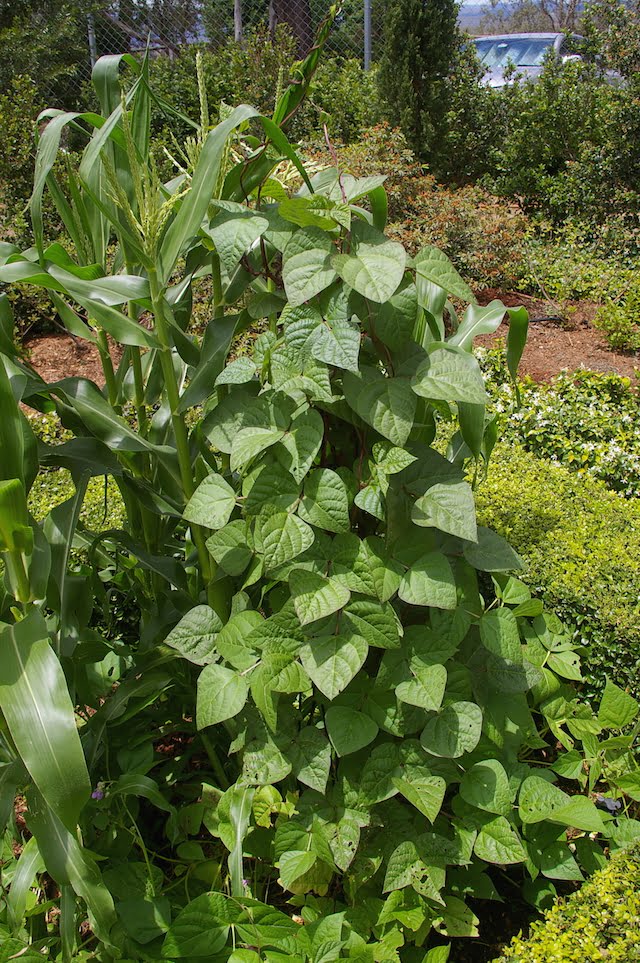
Climbing beans in a formal vegetable garden
In the ornamental garden
Beans can be ornamental features in the vegetable garden. Their lush growth, and varied coloured flowers or pods add interest. Many purple cultivars have a purplish cast to the leaf or stem. While most cultivars produce pods which may be hidden among the leaves, there are some which have been bed to display their beans above the foliage, for example, the bush bean ‘Purple Teepee’.

Climbing bean plants add vertical elements to the veggie garden
These days vegetable gardens are often located near to the house and gardeners take great pride in them. Vertical structures such teepees or conical frames can add interest in this landscape, can provide repetition along a path or can be designed to create archways or shelters. Climbing beans make great plants for growing up these structures as they are not too vigorous and generally look lush and well presented.
Make sure the structures you use are strong enough to support the plants. It is worth spending some time planning and building the structures as they can be recycled and reused again and again. Climbing beans can also be trained up trellis or wires along fences to provide a pleasant backdrop.
Intercropping can also be done while climbing beans are young, using fast growing crops such as radish or rocket at their base.
Some popular beans commercially available in Australia
‘Australian Butter’– a climbing butter (wax) bean with long deep cream pods with purplish brown seeds, Eat pods while young. Productive and tasty. (Diggers Club)
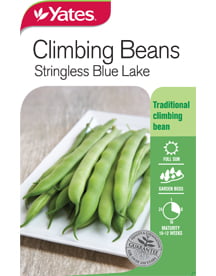
Stringless Blue Lake from Yates seeds
‘Blue Lake’ (White Creaseback, Missouri White Cornfield) – this popular climbing heirloom is said to have been grown by the Upper Missouri American Indians. It produces stringless flattened pods and has an excellent flavor. The seeds are white. Good bacterial resistance. Grows well in tropical and subtropical climates. (Yates, Diggers Club, Green Harvest, Eden Seeds, Green Patch, New Gippsland Seeds & Bulbs, Goodman Seeds, Mr Fothergills)
‘Borlotto Dwarf’ – this bush bean has ornamental, red flecked pods and red specked cream seeds. Shelled or dried beans are used in many classic European recipes. (Mr Fothergills, Diggers Club)
‘Borlotto Red Rooster’ – this bush Borlotto bean has very attractive mottled red pods. The seeds are tan with red specks. It is noted for its productivity and disease resistance. (Green Harvest)
‘Dragon’s Tongue’ (Dragon Langrie’, ’Lapwing’) – this European heirloom bush bean produces broad cream pods with purple flecks and an excellent flavor. The beans can be eaten fresh or dried. Not a vigorous cultivar and may fail in less than ideal conditions. (Diggers Club)
‘Giant of Stuttgart’ – a European heirloom climbing bean with flat, tender, very long tender pods. It is highly productive and a great favourite. (Diggers Club, New Gippsland Seeds & Bulbs)
‘Italian Romano’ – this semi-dwarf bean has long, wide and flat green pods. It is noted for its excellent texture and flavor. This bean has white seeds. (Diggers Club, Green Harvest)
‘Kentucky Wonder’ (‘Texas Pole’) – this early, hardy and highly productive climbing bean has long wrinkled pods, white flowers and brown seeds. It is a great performer in tropical and subtropical climates. (Eden Seeds, Green Patch)
‘Lazy Wife’ (Lazy Housewife, Sofia) – an heirloom, climbing green bean with delicious stringless pods and renown for its outstanding productivity. It has white flowers and white seeds. (Diggers Club, Eden Seeds, Green Patch)
‘Northeaster’ (‘Early Riser’, ‘Kwintus’) – this vigorous and productive climbing bean has flat beans with tasty green pods and white seeds. (Green Harvest)
‘Marveille de Venise’ (Marvel of Venice) – an heirloom climbing butter (wax) bean with delicious yellowish green pods. (Diggers Club, Goodman Seeds)
‘Pioneer’ – a climbing bean with crisp and succulent green beans which have brown seeds. (Mr Fothergills, Diggers Club)
‘Princess’ – a productive bush bean noted for its disease resistance and for its ability to germinate in cooler soils.
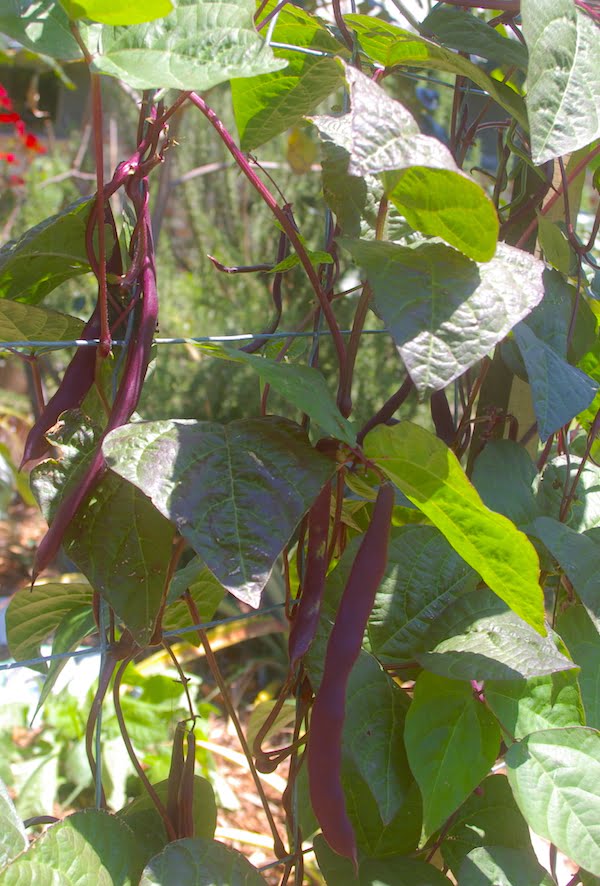
‘Purple King’ is one of the hardiest of all beans
‘Purple King’ – famous for its purple flowers, dark purple pods, purplish leaves and purple stems, this very vigorous and adaptable bean performs well in both cold and very hot conditions. It is very reliable in tropical and subtropical regions. (Yates, Diggers Club, Eden Seeds, Green Patch, New Gippsland Seeds & Bulbs, Goodman Seeds, Mr Fothergills, Mr Fothergills)
‘Purple Queen’ – an ornamental bush bean with purple pods and flowers and purplish stems and leaves. It is cold tolerant and suited to autumn planting in the subtropics. (Mr Fothergills)
‘Rattlesnake’ – this climbing bean has purplish flowers and ornamental round green pods flecked in purple. Seeds are brown.
‘Redland Beauty’, ‘Redland Greenleaf’ and ‘Redland Pioneer’ – these are bush beans bred by the Queensland Department of Primary Industries for their resistance to fungal diseases prevalent during the warm, wet summer conditions and thus recommended for subtropical and tropical areas. (Eden Seeds, Goodman Seeds)
‘Buerre de Rocquencourt’ (sometimes sold as ‘Roquefort Dwarf’) – this heirloom bush bean is renowned for its flavor and productivity and regarded by many as the best of all butter beans. It is named for the town of Rocquencourt near Verseille where it has been grown since the 1840s.
‘Roc D’or’ – producing straight slender golden yellow pods, with black seeds and purple flowers, this bush bean is noted for its productivity and disease resistance. It germinates well in cool soils and is thus suited to autumn planting in the subtropics. (Green Harvest, Green Patch)
‘Royal Burgundy’ – a bush bean with glossy tender violet-purple round pods. Noted for its flavor, productivity and disease resistance. (Green Harvest, Eden Seeds, Green Patch, New Gippsland Seeds & Bulbs)
‘Simba’ – this bush bean has fleshy dark green rounded pods. It is noted for its flavor, productiveness and disease resistance. (Green Harvest)
‘Speckled Cranberry’ – this climbing bean has crimson red pods lightly speckled with green. The pale tan seeds are speckled with red. It is used fresh, podded and dried and is a classic American Heirloom. (Diggers Club)
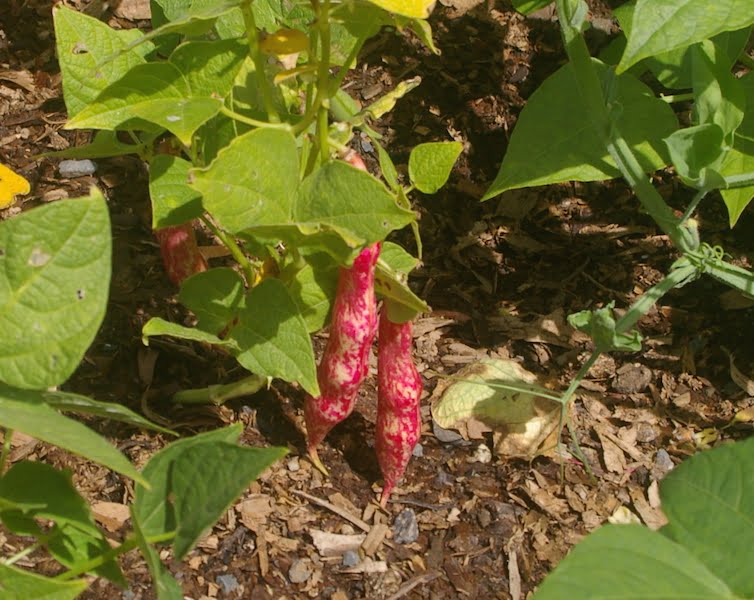
Tongue of Fire beans are hard to miss
‘Tongue of Fire’ – this semi-dwarf heirloom is said to be from Tierra del Fuego, at the southern tip of Argentina. The green pods have red flecking and the flowers are lilac. The large beans can be eaten fresh, podded or dried. (Eden Seeds, New Gippsland Seeds & Bulbs)
Seed Sources
Eden Seeds – www.edenseeds.com.au
Goodman seeds – www.goodmanseeds.com.au
Green Harvest – www.greenharvest.com.au
Green Patch – www.greenpatchseeds.com.au
Mr Fothergills – www.mrfothergills_seeds_bulbs.com.au
New Gippsland Seeds & Bulbs – www.newgipps.com.au
Select Organics – www.selectorganic.com.au
The Diggers Club – www.diggers.com.au
The Italian Gardener – www.theitaliangardener.com.au
The Lost Seed – www.thelostseed.com.au
Yates – www.yates.com.au
So for readers in cooler climates, start planning for your spring bean crops. Those in the colder parts of the southern hemisphere have many months to sit by the fire and leaf through catalogues. However gardeners in the warmer areas of Australia will need to get a move on. The temperatures are cooling and the ground is still moist. Prepare the beds and start building your frames. Over the next few weeks it will be time to plant those bean seeds and then to enjoy the delicious crops these prolific plants produce.
